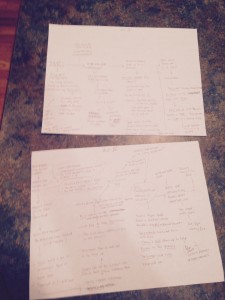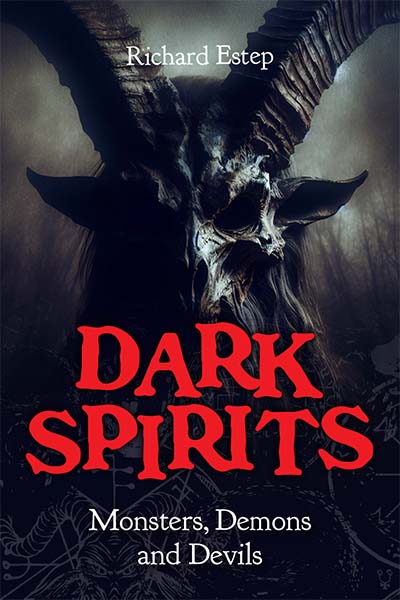*** SPOILER WARNING*** The photo attached to this post contain spoilers for my upcoming novel “Agonal Breath,” so if you intend to read it, please don’t read the plot outline first. This has been a public service announcement prompted by Mr. M. Night Shyamalan.
I’ve spoken to more than a few people who have begun writing a novel, novella, or a lengthy work of non-fiction, and have made a terrific start, flying out of the gate at warp speed – only to somehow tail off and fall by the wayside before getting anywhere close to the finish line.
Why does this happen?
Part of the reason is human nature. Call it what you will – inertia covers it nicely, as does Steven Pressfield’s preferred term resistance – but there is a definite tendency for such creative projects to lose their way and fizzle out once more than a few thousand words are in the bag. There’s nothing quite like opening up that brand new Microsoft Word (or even better, Scrivener) file, and seeing the almost unlimited potential of a blank canvas spread out before you. In some ways, it’s very liberating; in others, terrifying. How the hell are you going to fill that with 60, 70, 80,000 words or more…?
So you make a great start. Chances are, you know at least roughly where the story is heading. You start establishing some of the characters, situations, and ground rules of your world. And then…the inner critic begins to take over. Your writing is suddenly crap. Your characterization is hollow. None of the dialogue rings true…or so he (or she) tells you. Why not just quit now, that seductive voice whispers, before you embarrass yourself? Nobody’s going to want to read this.
Before you know it, you’ve succumbed to temptation and shelved your project…probably never to return to it again.
One of the best ways to combat this tendency is to outline before you start. To a lot of writers, constructing an outline is somewhere akin to getting a root canal in terms of desirability: “But it restricts the free flow of creativity!” is a common reaction. But here’s the thing – outlining your book, story, whatever, provides you with that invaluable pathway through the swamp that will get you to the end. Maybe battered, bruised, and bleeding, but it will get you to the end. Which isn’t to say that you must adhere to it slavishly, that you can’t deviate from it when the muse strikes; but you will always be drawn back to the path, your lifeline. One end is firmly affixed to the words “THE END” and the other to wherever you are writing at the moment.
There are many ways to structure an outline, but one of the most common (because it works) is the three-act structure. It really is as simple as “beginning, middle, end,” like any good story. Of course, the devil is in the details, but filling out those details is a damn sight less daunting when you are working to a plan. You start at the beginning, obviously, and you need some sense of where the story is going to end up. Then you need to chart out your major story beats (structural milestones) within the narrative, working your way through the key plot points from a grand, top-down perspective.
Some authors (again, Steven Pressfield is a huge advocate of this method) like to use a single sheet of A4-size paper, divide it into three sections, and write their outline on that. I like a little more detail, so I use three sheets, one for each act. I’ll usually write the very beginning of act I, the end of act III, and then start working between the two points…sometimes backwards through act III in reverse order, other times forwards from act I’s beginning. Ultimately, the two parts of the outline meet in the middle. Leave lots of blank space for diversions and side-steps where relevant, and you have yourself a skeleton for your book.
I’ve included an overview of my outline for acts II and III of my current book, “Agonal Breath,” to give a rough idea of what my outline structure looks like.



3 Responses
You outline by using a single sentence first. Then expand that to a paragraph, to a page, to pages. As you go, keep the acts balanced in size, pacing, and drama. Continue until you have the entire piece. Try it: practice by writing a one-sentence outline of The Sixth Sense, or whatever, then expand that to, say, three paragraphs, then repeat with a different story. Every story, if it has any merit, can be told at any scale between extremes. The upper extreme is a moment-by-moment account (too long and boring to be art, that’s how lives are lived); the lower limit is, as I say, a sentence (which is of course too short to be effective art, but an effective tool for you to understand your story in its most irreducible form). Oh, and an outline is a spoiler. An outline has two functions as a tool: the first is to guide the writer’s creativity, to allow them to try many different variants of the story in extremely short form (saying that outlining limits the flow of creativity is to fail to grok what outlining is at its essence). The second is to test the story’s value with readers. Write out ten outlines, as varied as you like, each three paragraphs long and test them with folks. Expand the winner or winners to a couple pages then repeat until the outline is long enough to take it across the finish line alone. Showing a real outline to someone for any other reason is a waste of art, because you just spoiled your story. This blog post could have shown some made-up examples of outlines instead of showing a real one.
Dear Mr. Shyamalan,
While I don’t for one second think that this is actually M. Night Shyamalan posting, I’m going to respond to it as if it is, simply because I really, *really* want to live in a universe where the guy who wrote and directed the masterpiece that is “The Sixth Sense” stumbles upon my humble little blog and posts a thoughtful and insightful comment such as this.
In short, you make a very valid point about my having posted spoilers for the novel by publishing the genuine outline for it. My rationale was that readers might be interested in seeing the nuts and bolts of how the narrative was constructed. I suspect that those who read the outline and find it interesting will still want to read the novel, and that I will have done no harm to those who would not find the book to be quite their cup of tea in the first place. However, it was remiss of me not to inform readers in advance that the post contained spoilers, so I have modified it to contain a spoiler warning.
“The Sixth Sense” is probably my favorite ghost story of all time. Thanks for taking the time to write, man.
Cheers,
Richard
Richard, your reply got me thinking about horses and zebras. Horses and zebras are very creative, very entertaining and impactful storytelling elements that are large-scale enough in structure to show up in even a fairly short outline. I daresay your readers have heard the advice given to medical students about opting for the most likely etiology for a given set of symptoms (rather than imagining some exotic illness). They say, “When you hear hoofbeats, don’t think zebras”. That seems like redundant advice, actually, because when most folks hear hoofbeats they very naturally picture a horse umprompted. Therefore when we’re telling stories, we can sometimes exploit this tendency by having it turn out to have been a zebra all along, and of course audiences love the thrill of discovery, and of twist, when that kind of thing happens. It’s like a gift they weren’t expecting. Case in point is of course the classic hoofbeats in The Sixth Sense. The hoofbeats are: the caption “six months later”, and then the scenes where we see Malcolm with a new set of case notes and his apparently perfectly workmanlike interactions with Cole. What are we to make of those hoofbeats? Obviously Malcolm healed and he’s on to his next case. That would be the horse interpretation. It’s not until the end of the film that we discover… the zebra! The zebra interpretation, I mean. Which we were extremely unlikely to plump for spontaneously, and yet when we look back at every hoofbeat that has passed, a zebra actually does fit the evidence as well as a horse did, and so we’re doubly delighted. Having the audience go for the horse interpretation sometimes depends on the human tendency to make assumptions. For example, my name, my talking about writing, my mentioning the Sixth Sense, are hoofbeats the obvious interpretation of which must be that I’m pretending to be the well-known MNS. There is a zebra interpretation, though, which is just that I happen to share the same name, and be a writer. And that I’m, naturally, a fan of The Sixth Sense, I mean who isn’t? 🙂 I’ll be listening in next time you’re on Coast To Coast AM, keep up the good work!